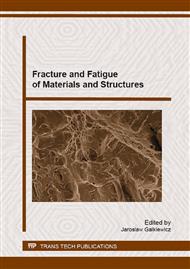[1]
F. Ellyin, D. Kujawski, Plastic strain energy in fatigue failure, Journal Pressure Vessel Technology, 1984, pp.342-347.
DOI: 10.1115/1.3264362
Google Scholar
[2]
K. Gołas, F. Ellyin, A total strain energy theory for cumulative fatigue damage, Journal Pressure Vessel Technology, 1988, pp.35-41.
DOI: 10.1115/1.3265565
Google Scholar
[3]
T. Lagoda, Energetyczne modele trwałosci zmeczeniowej materiałow konstrukcyjnych w warunkach jednoosiowych i wieloosiowych obciazen losowych, Studia i monografie nr 121, Wydawnictwo Politechniki Opolskiej, (2001).
Google Scholar
[4]
J. Kaleta, Doswiadczalne podstawy formułowania energetycznych hipotez zmeczeniowych, Oficyna Wydawnicza Politechniki Wrocławskiej, (1998).
Google Scholar
[5]
B. Ligaj, Effect of stress ratio on the cumulative value of energy dissipation, Trans Tech Publikations, Key Engineering Materials, vol. 598 (2014), pp.125-132.
DOI: 10.4028/www.scientific.net/kem.598.125
Google Scholar
[6]
A. Lipski, S. Mrozinski, Approximate determination of a strain-controlled fatigue life curve for aluminum alloy sheets for aircraft structures. International Journal of Fatigue, 2012, 39, pp.2-7.
DOI: 10.1016/j.ijfatigue.2011.08.007
Google Scholar
[7]
S. Mrozinski, Stabilization of cyclic properties in metals and its influence on fatigue life, (in Polish), Monographs nr 128, Publishing house University of Science and Technology, Bydgoszcz, (2008).
Google Scholar
[8]
L. Pejkowski, D. Skibicki, J. Sempruch, High-Cycle Fatigue Behavior of Austenitic Steel and Pure Copper under Uniaxial, Proportional and Non-Proportional Loading, Strojniski Vestnik- Journal of Mechanical Engineering, vol.: 60 (2013), pp.549-560.
DOI: 10.5545/sv-jme.2013.1600
Google Scholar
[9]
G. Szala, Comments on linear summation hypothesis of fatigue failures, Polish Maritime Research, vol.: 21 (2014), pp.77-85.
DOI: 10.2478/pomr-2014-0033
Google Scholar
[10]
G. Szala, B. Ligaj, Description of cyclic properties of steel in variability conditions of mean values and amplitudes of loading cycles, Fatigue Failure and Fracture Mechanics, Book series: Materials Science Forum, vol.: 726 (2012), pp.69-76.
DOI: 10.4028/www.scientific.net/msf.726.69
Google Scholar
[11]
J. Szala, Hypotheses of fatigue damage accumulation, (in Polish), Monographs, University of Technology and Agriculture, Bydgoszcz (1998).
Google Scholar
[12]
T. Tomaszewski, J. Sempruch, Verification of the fatigue test method applied with the use of mini specimen, Fracture and Fatigue of Materials and Structures, Book series: Key Engineering Materials, vol.: 598 (2014), pp.243-248.
DOI: 10.4028/www.scientific.net/kem.598.243
Google Scholar
[13]
B. Ligaj, G. Szala, Hybrid Calculation Method of Fatigue Life, (in Polish), Monographs, Publishing house Institute for Sustainable Technologies – National Research Institute, Radom, (2013).
Google Scholar


